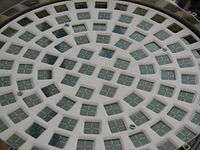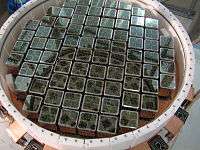XENON
The XENON dark matter research project operated at the Italian Gran Sasso laboratory is a deep underground research facility featuring increasingly ambitious experiments aiming to finally detect long sought after dark matter particles. These particles in the form of Weakly interacting massive particles (WIMPs) are believed to be found by looking for rare interactions via nuclear recoils in a liquid xenon target chamber. The current detector consists of a dual phase Time projection chamber (TPC).
The experiment detects scintillation and ionization produced when particles interact in the liquid xenon volume, to search for an excess of nuclear recoil events over known backgrounds. The detection of such a signal will provide the first direct experimental evidence for dark matter candidate particles. The collaboration is currently led by Italian professor of physics Elena Aprile from Columbia University.
Detector Principle

The XENON experiment operates a dual phase Time projection chamber (TPC), which utilizes a liquid xenon target with a gaseous phase on top. Two arrays of photomultiplier tubes (PMTs), one at the top of the detector in the gaseous phase (GXe), and one at the bottom of the liquid layer (LXe), detect scintillation and electroluminescence light produced when charged particles interact in the detector. Electric fields are applied across both the liquid and gaseous phase of the detector. The electric field in the gaseous phase has to be sufficiently large to extract electrons from the liquid phase
Particle interactions in the liquid target produce scintillation and ionization. The prompt scintillation light produces 178 nm ultraviolet photons. This signal is detected by the PMTs, and is referred to as the S1 signal. This technique has proved sensitive enough to detect single photoelectrons.[1] The applied electric field prevents recombination of all the electrons produced from a charged particle interaction in the TPC. These electrons are drifted to the top of the liquid phase by the electric field. The ionization is then extracted into the gas phase by the stronger electric field in the gaseous phase. The electric field accelerates the electrons to the point that it creates a proportional scintillation signal that is also collected by the PMTs, and is referred to as the S2 signal.
The detector allows for a full 3-D position determination[2] of the particle interaction. Electrons in liquid xenon have a uniform drift velocity. This allows the interaction depth of the event to be determined by measuring the time delay between the S1 and S2 signal. The position of the event in the x-y plane can be determined by looking at the number of photons seen by each of the individual PMTs. The full 3-D position allows for the fiducialization of the detector, in which a low-background region is defined in the inner volume of the TPC. This fiducial volume has a greatly reduced rate of background events as compared to regions of the detector at the edge of the TPC, due to the self-shielding properties of liquid xenon. This allows for a much higher sensitivity when searching for very rare events.
Charged particles moving through the detector are expected to either interact with the electrons of the xenon atoms producing electronic recoils, or with the nucleus, producing nuclear recoils. For a given amount of energy deposited by a particle interaction in the detector, the ratio of S2/S1 can be used as a discrimination parameter to distinguish electronic and nuclear recoil events.[3] This ratio is expected to be greater for electronic recoils than for nuclear recoils. In this way backgrounds from electronic recoils can be suppressed by more than 99%, while simultaneously retaining 50% of the nuclear recoil events.
XENON10

The XENON10 experiment was installed at the Gran Sasso underground laboratory in Italy during March 2006. The underground location of the laboratory provides 3100m of water-equivalent shielding. The detector was placed within a shield to further reduce the background rate in the TPC. XENON10 was intended as a prototype detector, to prove the efficacy of the XENON design, as well as verify the achievable threshold, background rejection power and sensitivity. The XENON10 detector contained 15 kg of liquid xenon. The sensitive volume of the TPC measures 20 cm in diameter and 15 cm in height.[4]
An analysis of 59 live days of data, taken between October 2006 and February 2007, produced no WIMP signatures. The number of events observed in the WIMP search region is statistically consistent with the expected number of events from electronic recoil backgrounds. This result excluded some of the available parameter space in minimal Supersymmetric models, by placing limits on spin independent WIMP-nucleon cross sections down to below 10−43cm2 for a 30 GeV/c2 WIMP mass.[5]
Due to nearly half of natural xenon having odd spin states (129Xe has an abundance of 26% and spin-1/2; 131Xe has an abundance of 21% and spin-3/2), the XENON detectors can also be used to provide limits on spin dependent WIMP-nucleon cross sections for coupling of the dark matter candidate particle to both neutrons and protons. XENON10 set the world's most stringent restrictions on pure neutron coupling.[6]
XENON100


The second phase detector, XENON100, contains 165 kg of liquid xenon, with 62 kg in the target region and the remaining xenon in an active veto. The TPC of the detector has a diameter of 30 cm and a height of 30 cm. As WIMP interactions are expected to be extremely rare events, a thorough campaign was launched during the construction and commissioning phase of XENON100 to screen all parts of the detector for radioactivity. The screening was performed using High Purity Germanium detectors. In a few cases mass spectrometry was performed on low mass plastic samples. In doing so the design goal of <10−2 events/kg/day/keV [7] was reached, realising the world's lowest background rate dark matter detector.
The detector was installed at the Gran Sasso Laboratory in 2008 in the same shield as the XENON10 detector, and has conducted several science runs. In each science run, no dark matter signal was observed above the expected background, leading to the most stringent limit on the spin independent WIMP-nucleon cross section in 2012, with a minimum at 2.0 × 10−45cm2 for a 65 GeV/c2 WIMP mass.[8] These results constrain interpretations of signals in other experiments as dark matter interactions, and rule out exotic models such as inelastic dark matter, which would resolve this discrepancy.[9] XENON100 has also provided improved limits on the spin dependent WIMP-nucleon cross section.[10] An axion result was published in 2014,[11] setting a new best axion limit.
XENON100 operated the then-lowest background experiment, for dark matter searches, with a background of 50 mdru (1 mdru = 10−3 events/kg/day/keV).[12]
XENON1T
Construction of the next phase, XENON1T, started in Hall B of the Gran Sasso national Laboratory in 2014. The detector is designed to contain 3.5 tons of ultra radio-pure liquid Xenon, and will have a fiducial volume in excess of 1 ton. The detector is housed in a 10 m water tank that will serve as a muon veto. The TPC will be 1 m in diameter and 1 m in height. The predicted sensitivity at 50 GeV/c2 is 2.0 x 10−47 cm2. This is 100x lower than the current limit published for XENON100.
It is expected to explore/test supersymmetry candidates such as CMSSM.[13]
As of August 2016 "On March 17th [2016], the TPC was filled with warm xenon gas for the first time, ... to acquire the first scintillation signals with the detector."[14]
Collaborating institutions
XENON1T
Gran Sasso National Laboratory (Italy), Johannes Gutenberg University, Mainz (Germany), Columbia University (USA), Max-Planck-Institut fur Kernphysik (Germany), Rice University (USA), SUBATECH, Universite de Nantes (France), University of Bologna and INFN-Bologna (Italy), University of California - Los Angeles (USA), University of California - San Diego (USA), University of Coimbra (Portugal), University of Munster (Germany), University of Zurich (Switzerland), Nikhef (Netherlands), Weizmann Institute of Science (Israel), Purdue University (USA), University of Bern (Switzerland) Rensselaer Polytechnic Institute (USA) Stockholm University (Sweden) New York University Abu Dhabi (United Arab Emirates) University of Chicago (USA)
XENON100
Columbia University (USA), Johannes Gutenberg University, Mainz (Germany), Gran Sasso National Laboratory (Italy), Max-Planck-Institut fur Kernphysik (Germany), Rice University (USA), SUBATECH, Universite de Nantes (France), University of Bologna and INFN-Bologna (Italy), University of California - Los Angeles (USA), University of Coimbra (Portugal), University of Munster (Germany), University of Zurich (Switzerland), Nikhef (Netherlands), Weizmann Institute of Science (Israel), Purdue University (USA), University of Bern (Switzerland), Shanghai Jiao Tong University (China) Stockholm University (Sweden) New York University Abu Dhabi (United Arab Emirates) University of Chicago (USA)
XENON10
Brown (USA), Case Western Reserve (USA), Columbia University (USA), Gran Sasso National Laboratory (Italy), Lawrence Livermore National Laboratory (USA), Rice University (USA), University of Coimbra (Portugal), University of Zurich (Switzerland), Yale (USA)
References
- ↑ E. Aprile; The XENON100 Collaboration; et al. (2014). "Observation and applications of single-electron charge signals in the XENON100 experiment". J. Phys. G: Nucl. Part. Phys. 41: 035201. arXiv:1311.1088
 . Bibcode:2014JPhG...41c5201A. doi:10.1088/0954-3899/41/3/035201.
. Bibcode:2014JPhG...41c5201A. doi:10.1088/0954-3899/41/3/035201. - ↑ E. Aprile; The XENON100 Collaboration; et al. (2012). "The XENON100 Dark Matter Experiment". Astropart. Phys. 35 (537-590).
- ↑ E. Aprile; et al. (XENON) (2014). "Analysis of The XENON100 Dark Matter Search Data". Astropart. Phys. 54 (11-24).
- ↑ E. Aprile; The XENON10 Collaboration; et al. (2011). "Design and Performance of The XENON10 Experiment". Astroparticle Physics. 34: 679––698. arXiv:1001.2834
 . Bibcode:2011APh....34..679A. doi:10.1016/j.astropartphys.2011.01.006.
. Bibcode:2011APh....34..679A. doi:10.1016/j.astropartphys.2011.01.006. - ↑ J. Angle; The XENON10 Collaboration; et al. (2008). "First Results from the XENON10 Dark Matter Experiment at the Gran Sasso National Laboratory". Physical Review Letters. 100: 021303. arXiv:0706.0039
 . Bibcode:2008PhRvL.100b1303A. doi:10.1103/PhysRevLett.100.021303. PMID 18232850.
. Bibcode:2008PhRvL.100b1303A. doi:10.1103/PhysRevLett.100.021303. PMID 18232850. - ↑ J. Angle; The XENON10 Collaboration; et al. (2008). "Limits on spin-dependent WIMP-nucleon cross-sections from the XENON10 experiment". Physical Review Letters. 101: 091301. arXiv:0805.2939
 . Bibcode:2008PhRvL.101i1301A. doi:10.1103/PhysRevLett.101.091301.
. Bibcode:2008PhRvL.101i1301A. doi:10.1103/PhysRevLett.101.091301. - ↑ E. Aprile; The XENON100 Collaboration; et al. (2011). "Material screening and selection for XENON100". Astroparticle Physics. 35: 43–49. arXiv:1103.5831
 . Bibcode:2011APh....35...43A. doi:10.1016/j.astropartphys.2011.06.001.
. Bibcode:2011APh....35...43A. doi:10.1016/j.astropartphys.2011.06.001. - ↑ E. Aprile; The XENON100 Collaboration; et al. (2012). "Dark Matter Results from 225 Live Days of XENON100 Data". Phys. Rev. Lett. 109: 181301. arXiv:1207.5988
 . Bibcode:2012PhRvL.109r1301A. doi:10.1103/physrevlett.109.181301.
. Bibcode:2012PhRvL.109r1301A. doi:10.1103/physrevlett.109.181301. - ↑ E. Aprile; The XENON100 Collaboration; et al. (2011). "Implications on inelastic dark matter from 100 live days of XENON100 data". Phys. Rev. D. 84 (061101). arXiv:1207.5988
 . Bibcode:2012PhRvL.109r1301A. doi:10.1103/PhysRevLett.109.181301.
. Bibcode:2012PhRvL.109r1301A. doi:10.1103/PhysRevLett.109.181301. - ↑ E. Aprile; The XENON100 Collaboration; et al. (2012). "Limits on spin-dependent WIMP-nucleon cross sections from 225 live days of XENON100 data". Phys. Rev. Lett. 111: 021301. arXiv:1301.6620
 . Bibcode:2013PhRvL.111b1301A. doi:10.1103/PhysRevLett.111.021301.
. Bibcode:2013PhRvL.111b1301A. doi:10.1103/PhysRevLett.111.021301. - ↑ XENON100 Collaboration (2014). "First Axion Results from the XENON100 Experiment". Phys. Rev. D. 90: 062009. Bibcode:2014PhRvD..90f2009A. doi:10.1103/PhysRevD.90.062009.
- ↑ E. Aprile; The XENON100 Collaboration; et al. (2011). "Study of the electromagnetic background in the XENON100 experiment". Phys. Rev. D. 83 (082001). arXiv:1101.3866
 . Bibcode:2011PhRvD..83h2001A. doi:10.1103/physrevd.83.082001.
. Bibcode:2011PhRvD..83h2001A. doi:10.1103/physrevd.83.082001. - ↑ Roszkowski, Leszek; Sessolo, Enrico Maria; Williams, Andrew J. (11 August 2014). "What next for the CMSSM and the NUHM: improved prospects for superpartner and dark matter detection". Journal of High Energy Physics. 2014 (8). arXiv:1405.4289
 . Bibcode:2014JHEP...08..067R. doi:10.1007/JHEP08(2014)067.
. Bibcode:2014JHEP...08..067R. doi:10.1007/JHEP08(2014)067. - ↑ See : First Signals in the XENON1T Time Projection Chamber. 14 April 2016
Further reading
- Angle, J; et al. (2008). "First Results from the XENON10 Dark Matter Experiment at the Gran Sasso National Laboratory". Physical Review Letters. 100 (2): 021303. arXiv:0706.0039
 . Bibcode:2008PhRvL.100b1303A. doi:10.1103/PhysRevLett.100.021303. PMID 18232850.
. Bibcode:2008PhRvL.100b1303A. doi:10.1103/PhysRevLett.100.021303. PMID 18232850.
External links
- The XENON Experiment
- XENON home page at Columbia University
- XENON home page at the University of Zurich
- XENON home page at Rice University
- XENON home page at Brown University
- XENON home page at University of California, Los Angeles
- Dark matter limit plotter with the latest results from XENON and other experiments
- Enlightening the dark, CERN Courier, Sep 27, 2013
Coordinates: 42°25′14″N 13°30′59″E / 42.42056°N 13.51639°E
